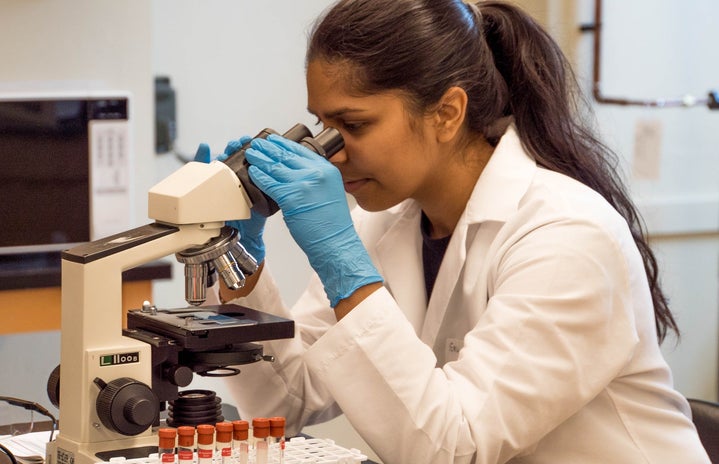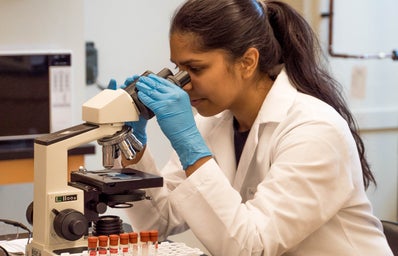Note: Where this article refers to “women” or “girls”, it is intended that these terms refer to a person’s self-defined gender – these terms are understood to include all those who identify as women, be they cisgender women, transgender women, and/or nonbinary women.
The label “Woman in STEM” along with other labels, such as “STEMinist”, has come into use over recent years. We have come to know these popular phrases from their use on social media platforms, namely Twitter, Instagram and the increasingly popular TikTok. They are memorable, attention-grabbing, and to the point. But what have they helped to achieve in the years since their creation?
In 2020, the World Economic Forum reported that less than 30% of the world’s science researchers are women. A 2017 study done by Ebony McGee and Lydia Bentley reveals that only 2% of employed scientists and engineers are black women, and that this clear under representation is a result of the difficulties experienced by these women early on in their STEM careers. These statistics point to a widespread problem that has not improved over time. McGee and Bentley highlight that gender and racial stereotypes as well as the lack of STEM programmes offered at lower income universities and colleges, where the majority of the student body are students of colour, may be reasons for this under representation in STEM. These gender and racial stereotypes further shape biases in educators – McGee and Bentley write that black women are often discouraged from pursuing a STEM programme, in favour of another academic path. This indicates a need for more support for women in STEM programmes, as well as encouragement for girls who show an interest in pursuing STEM at university level.
However, the drive to get women into STEM cannot just end with encouraging girls to pursue scientific courses in university. In her TEDx Talk, titled “Why do so many women leave their careers in STEM?”, Prasha Sarwate Dutra describes a “leaking bucket” that awaits young women when they enter the STEM working world. Dutra states that research has shown that over 40% of women employed in STEM fields leave their roles within 5 years. This shows that there is a clear need to not only encourage women to join STEM, but to keep them there. For this, Dutra believes that role models are required. Young female STEM employees need someone who they feel connected to and represented by.
This requires more exposure and celebration of the successes and contributions of women in STEM – the research and discoveries of these women can no longer be swept under the rug or credited to others. For evidence of this happening, one does not need to look far into the past – Rosalind Franklin is perhaps the most famous example of this. Her discovery of “Photo 51” was instrumental in the discovery of the structure of DNA – yet the Nobel Prize went to Watson and Crick, with no mention of Franklin. History repeats itself with the story of Jocelyn Bell Burnell, whose groundbreaking discovery of pulsars in the field of astrophysics went uncredited when the Nobel Prize went to her supervisor, Antony Hewish. The popular film “Hidden Figures” details the story of Katherine Goble Johnson, Dorothy Vaughan, and Mary Jackson. These three African American women were vitally important in their roles at NASA during the initial years of the NASA space programme, but faced extreme discrimination on the grounds of their race and gender. These examples from recent history should serve as lessons on what must be avoided to create a viable future for women in STEM.
Another largely unknown but profoundly serious problem in some STEM fields is the epidemic of sexual assault women have faced while on field trips for research in their discipline. A 2014 article by Anna Simmonds titled “Many women scientists sexually harassed during fieldwork” reveals the staggering numbers of women who have faced sexual assault while working in the field. Reportedly 64% of women have experienced a form of harassment while researching in the field, and 22% of women had experienced sexual assault. These figures come from a 2014 survey done by Clancy et al. This survey also indicates that many of the survivors of sexual assault and harassment were trainees, and that they had been targeted by their more senior male counterparts. This clear abuse of power points to the need for better policies to protect women and allow them to report these instances of severe workplace misconduct.
Overall, as catchy and inspirational as this label may be, it has not managed to find a solution to the problem it was perhaps created to solve. The issue of under representation of women, particularly women of colour, in STEM fields is multi-faceted, and requires long-term change and investment into the careers of young women in STEM. This would help to increase the number of women in these fields.
However, it is not all bad – a review of literature from 2007 to 2017 by Heidi Blackburn shows that gradually, there has been an increase in funding initiatives to provide opportunities for women in STEM programmes. Blackburn further indicates that it has become clear that early exposure to STEM has helped girls and young women to choose STEM as their future career path. This indicates that opportunities for early exposure must continue to be provided to young girls, and that their interest in STEM fields should be nurtured as much as possible.
There is much more to be discussed regarding this topic, but for now it can be said that there is hope – as long as we keep working towards a future of true egality.


